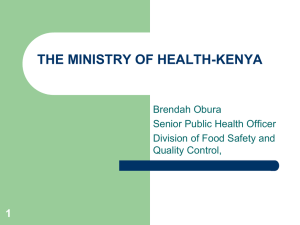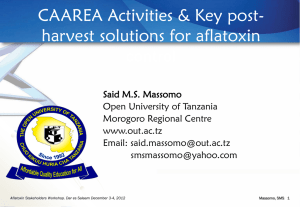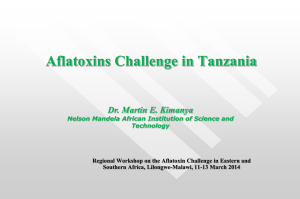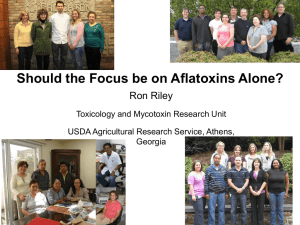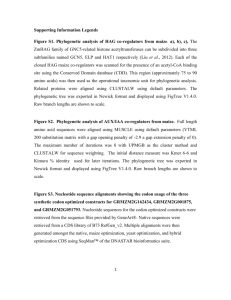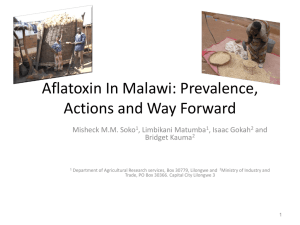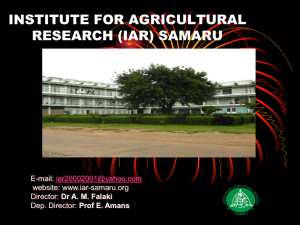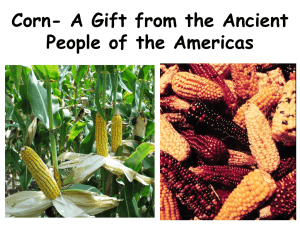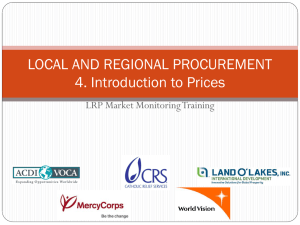Table 1 - Abt Associates
advertisement
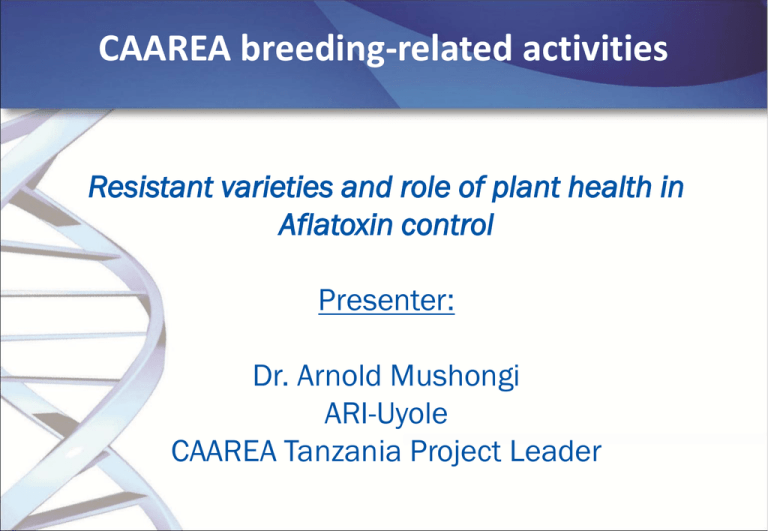
CAAREA breeding-related activities Resistant varieties and role of plant health in Aflatoxin control Presenter: Dr. Arnold Mushongi ARI-Uyole CAAREA Tanzania Project Leader Maize research status in developing countries Losses of maize grain yield due to various stresses in the developing world •Lost to stem borers = >10% •Lost to post harvest pests = >15% •Total insect pests = >25% Loss of quality less studied!!! 2 Background in Tanzania • Tanzania people: 44 million • 85% of Tanzanians depend on maize • 60% dietary calories, 50% daily protein; maize also cash crop; multiple uses (including feed) • Per capita consumption: annual 112.5kg (308g/person/day); national utilization ~3million metric tons(TFSD, 1996); GY = 3.66mt [FAOSTAT 2007] i.e. production ~ consumption • very low maize productivity: <1.5t/ha vs potential of 8t/ha due to multiple factors --- use 9kg/ha fertilizer (AFS, 2006), poverty, unstable climate, etc 4 More and more Varieties needed that: • A. Yield higher • B. Are safe for human and livestock consumption – Plant health is key in achieving a) and b) above, since a stressed genotype will succumb to the stressors and consequently ill performance • Achieving a) and b) will contribute to improving national food security, alleviate poverty 5 Current interventions • Two breeding projects on maize • I. On improved production and productivity • II. Food safety and human nutrition – Challenge: chances are limited to have varieties that have outstanding higher yields and are aflatoxin resistant – Efforts done to strike a balance – Note further that no crop variety in Tanzania are proven to be resistant to aflatoxin accumulation (TOSCI, 01 December 2012 – pers. comm.) 6 Project I: AGRA • Title: Towards improvement and adoption of African Crops: Production, testing, promotion and distribution of seeds of improved hybrid Maize cultivars in the intermediate and transition-to-low altitude zones of Tanzania • Goal: To improve national food security and the livelihoods of poor rural farmers through access to new improved maize cultivars and an efficient quality seed production and distribution system in Tanzania 7 Key activities Inbred-hybrid generation and evaluation Maintenance breeding Population improvement Production of breeder and pre-basic seed for ASA and private sector Promote and use participatory maize breeding Convening meetings embracing PPP approach in the local seed industry Extension messages on good agronomic practices for maize production 8 Targeted traits • High grain yield • Early maturity • Mitigating consequences of climate change – Drought tolerance – Striga weed tolerance – Maize streak virus tolerance – Early maturity – Other key biotic and abiotic stresses – Market traits i.e. end user preferences 9 Project II specifically on breeding for resistance to Aflatoxin accumulation: Milestones • 16 in total – Subdivided mainly to: 1. interacting with key stakeholders 2. National wide survey 3. Human/staff and institutional support 4. Field trials (inoculated and uninoculated) 5. Biobanking, manuscript publications 6. Strategic (culture of moving from Data to decision making) --- success of CAAREA !!!!! 10 … Breeding target: GY + MA tolerance/resistance • Eco-biological + socioeconomic issues: drought, low soil fertility (N), high temperature, insect/disease resistance (pre, postharvest), farmers preferences, etc • Traits: GY components, tight husk cover, closed ear tips, flintier kernels, long EFPD, fast KDD, earliness, drooped ears, etc – Secondary traits targeted due to low heritability of aflatoxin accumulation cf. other types of mycotoxins – Implication: highly influenced by GxE interaction, more environments required to validate results 11 Ear/kernel rots A. Flavus and A. parasitucus produce aflatoxins • • • • • • • Pre-harvest: Maize ear samples (250) collected from 10 sites (low and highland maize) Period: June-July 2012 Post-harvest: same sites Period: SeptemberOctober 2012 Trials planted at in two planting regimes in two sites with A. flavus (Table 1) Secondary traits bred for and evaluated by MSc student in lowland maize NxP fertiliser trial done by another MSc students in the Southern Highlands 13 Continous work: Field trial panels, planting, modeling • Field trial (inoculated) – 40 entries (20 inbred lines, 10 highly advanced experimental hybrids, 10 very popular commercial hybrids) – FT uninoculated 10 popular varieties per agro-zone i.e. 20 experimental stations across Tanzania – data collection: weather, phenotypic – data analysis, modeling, risk maps-aflatoxin, stresses 14 Automatic weather station at trial site 15 Table 1: Laboratory results of fungal isolates (%) Site Aspergillus flavus niger carbonareous Igeri (Njombe) 13.4 7.4 14.8 Seatondale (Iringa) 2.2 0 0 Mbimba (Mbeya) 0 0 0 Ismani (Iringa) 0 0 0 Milundikwa (Rukwa) 0 0 0 Mitalula (Mbeya) 0 0 0 ARI-Uyole (Mbeya) 0 0 16 0 Capacity building • • MSc students (Christine Kaswahili, Sokoine University of Agriculture; and Samuel Msuya, Open University of Tanzania; Nursery crossing block at ARI-Ilonga (Dr Mushongi and MSc student Ms Christina Kaswahili) 17 From R. Nelson, Cornell University From R. Nelson, Cornell University From R. Nelson, Cornell University Aflatoxin level tested inbred lines (CAAREAKenya) 0-20ppb 20-100ppb Above 100ppb Inoculated maize genotypes (entries) FT2FT2 analysis beginning January overlap of genotypes in Tanzania quicker, more confident answers analysis beginning Januarynotypes in Tanzania confident answers Potential opportunities for scaling up • Successful models developed from this project would be applied to – other crops where aflatoxin is a problem – as decision support systems along the nodes of crop value chain – reliably predict and demarcate target population of environments as hotspots for breeding goals against aflatoxin accumulation (including other mycotoxins in other food and feed systems) 23 ……Potential opportunities for scaling up • Human and institutional capacity building would foster national efforts to mitigate the problem in long run • Sustainable impact would result from the approach emphasized by AGRA of promoting the PPP approach in the local seed industry; breeding and releasing new varieties; and cooperation with local government, ASA and TOSCI. – For instance from the CAAREA research outputs, TOSCI would be advised to include a criterion of resistance/tolerance to aflatoxin in major crops before their varieties are released while ASA and the private sector could popularize use of such varieties. 24
